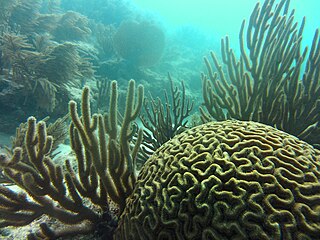
Avena brevis, the short oat, is a species of grass, and its seeds are edible.

Galathea strigosa is a species of squat lobster found in the northeast Atlantic Ocean, from the Nordkapp to the Canary Islands, and in the Mediterranean Sea and Red Sea. It is edible, but not fished commercially. It is the largest squat lobster in the northeast Atlantic, reaching a length of 90 millimetres (3.5 in), or a carapace length of 53 mm (2.1 in), and is easily identified by the transverse blue stripes across the body.

Byrrhidae, the pill beetles, is a family of beetles in the superfamily Byrrhoidea. These beetles are common in the forests of the Northern Hemisphere. They feed mainly on moss. Populations increase after wildfires. The oldest undoubted record of the family is Lidryops from the earliest Late Cretaceous Charentese amber of France, with other less certain records going back to the Middle Jurassic, but these possibly belong to Byrrhoidea.
Epidauria strigosa is a species of snout moth in the genus Epidauria. It was described by Staudinger in 1879, and is known from Turkey, Greece, Romania, Bosnia and Herzegovina, Croatia, Spain and Portugal.
Rhytidocystis is a genus of apicomplexans.

Pseudodiploria strigosa, the symmetrical brain coral, is a colonial species of stony coral in the family Mussidae. It occurs on reefs in shallow water in the West Atlantic Ocean and Caribbean Sea. It grows slowly and lives to a great age.
Calidota strigosa, the streaked calidota moth, is a moth of the family Erebidae. It was described by Francis Walker in 1855. It is found on the Antilles and from the southern United States to Central America.

Old Copse, Beenham is an 8-hectare (20-acre) biological Site of Special Scientific Interest south of Beenham in Berkshire. The site is private land with no public access.
Strangalia strigosa is a species of flower longhorn in the beetle family Cerambycidae. It is found in North America.
Curimopsis echinata is a species of pill beetle in the family Byrrhidae. It is found in North America.

Curimopsis is a genus of pill beetles in the family Byrrhidae. There are more than 30 described species in Curimopsis.
Curimopsis albonotata is a species of pill beetle in the family Byrrhidae. It is found in North America.
Zascelis is a genus of hidden snout weevils in the beetle family Curculionidae. There are more than 80 described species in Zascelis.
Curimopsis setulosa is a species of pill beetle in the family Byrrhidae. It is found in North America.

Epicauta strigosa is a species of blister beetle in the family Meloidae. It is found in North America.

Stelidota is a genus of sap-feeding beetles in the family Nitidulidae. There are about 15 described species in Stelidota.

Clostera strigosa, the striped chocolate-tip or drab tent-maker moth, is a species of moth in the family Notodontidae. It was first described by Augustus Radcliffe Grote in 1882 and it is found in North America.

Bathythrix is a genus of ichneumon wasps in the family Ichneumonidae. There are at least 60 described species in Bathythrix.

Stony coral tissue loss disease (SCTLD) is a disease of corals that first appeared off the coast of Florida in 2014. By 2019 it had spread along the Florida Keys and had appeared elsewhere in the Caribbean Sea. The disease completely destroys the soft tissue of many species of stony coral, killing them within weeks or months of becoming infected. The causal agent is unknown but is suspected to be a bacterium. The degree of susceptibility of a coral, the symptoms, and the rate of progression of the disease vary between species.

Echinopsis strigosa, is a species of Echinopsis found in Argentina.










